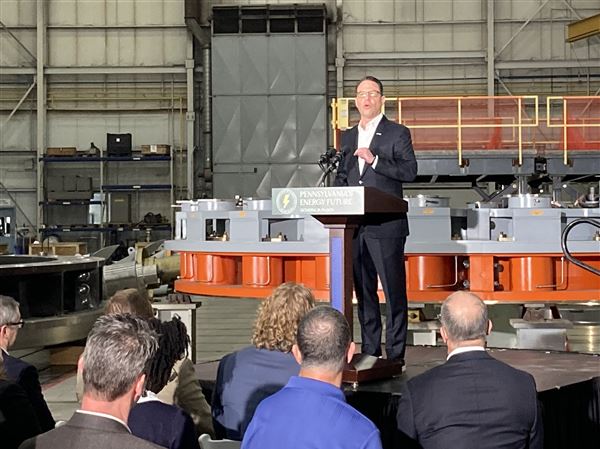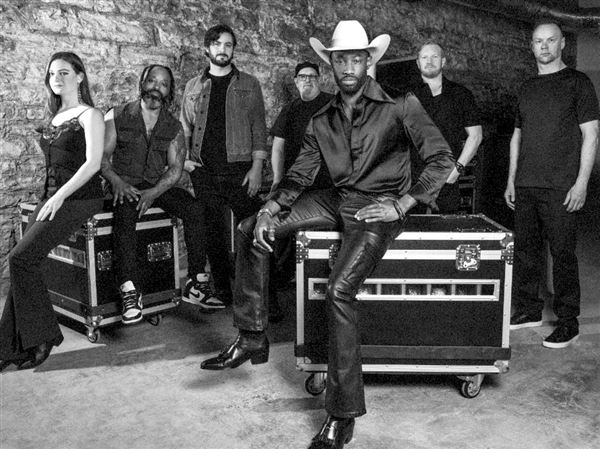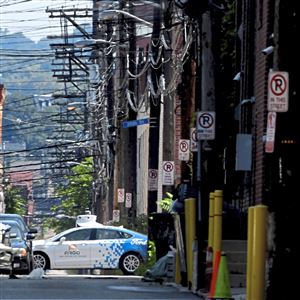No driver likes being stuck between two trucks barreling down the highway — especially when one of those trucks is driving itself.
That’s not likely to happen anytime soon. But that’s only because autonomous vehicles being put on the roads are set up to follow one another too closely for any driver to nudge their way in, said Cetin Mericli, co-founder and CEO of trucking technology company Locomation.
Based on the North Side, Locomation is bringing its self-driving trucks off the test track and onto the highway this spring. The company recently announced a partnership with transportation logistics company Wilson Logistics to move cargo on autonomous trucks more than 400 miles between Oregon and Idaho.
To get self-driving trucks on the highway, Locomation uses a convoy system. One truck — driven by a human — will lead, guiding the trailing autonomous truck down the highway and helping it to stay between the lines, navigate lane changes and avoid other cars.
“When the convoy is in action, only one driver is active, but two trucks are moving,” said Mr. Mericli, who founded the company with his brother Tekin.
“The point is the autonomous truck is smart enough to keep everyone safe,” Cetin Mericli said. “Whatever a human driver can do, our system can do.”
That technology seems especially relevant at a time when the spread of COVID-19 is keeping millions of people indoors, causing a spike in demand for deliveries.
Similar to self-driving cars, the company’s trucks use an intricate system of cameras, lidar (light detection and ranging) and radar sensors to “see” the surroundings. The trucks are well-equipped with sensors so that they don’t have any blind spots, Tekin Mericli said.
To talk to one another, the trucks use antennas equipped for “vehicle-to-vehicle communication” — sharing data about speed, acceleration, steering wheel angle, and the amount of throttle and brake being applied.
Unlike most self-driving cars, Locomation’s autonomous trucks are not designed to rely on a human to intervene if something goes wrong. That means there doesn’t have to be a person sitting behind the steering wheel ready to react at a moment’s notice if the technology makes a mistake or doesn’t know what to do.
Instead, when the truck is operating in autonomous mode, the driver is encouraged to move to the back of the vehicle to stretch out in the “sleeper berth.”
For Locomation’s deliveries this spring, a driver will still be behind the wheel to make sure everything goes smoothly. But the long-term goal is to free up time for drivers to take a break, relax and even go to sleep while the truck does all the work.
An evolving industry
Already, human-driven trucks are starting to come equipped with more technology, like advanced safety features to help the driver; cameras to record the road and surrounding cars; and GPS tracking to keep a log of where, and how fast, a driver went.
The industry itself is also moving toward more high-tech operations: Drivers now have to log their hours electronically rather than using pen and paper. Mobile apps connect drivers with open rest stops that have plenty of space available.
Idelic, a North Side-based startup, is developing a system that uses machine learning and driver data to predict accidents before they occur.
Maven Machines, a startup in Bloomfield, created a headset to monitor driver fatigue and help the workers stay alert. It also developed a fleet management cloud platform that helps companies track their loads and efficiently organize their jobs.
“We automate a lot of things to allow them to do a significantly more efficient job of running this complex operation where you have hundreds of thousands of vehicles and drivers out on the road,” said Maven Machines CEO Avi Geller. “As the vehicles become more sophisticated, you need a more sophisticated fleet management platform.”
Trucks moved 11.5 billion tons of freight in 2018 and made nearly $800 billion in revenue, according to data from the American Trucking Association.
Cetin Mericli predicts that driver assistance features will become standard in the industry in the next five years. Autonomous trucks may take a little longer to become the norm.
“In reality, it’s just going to be such a slow evolution, instead of a revolution,” he said.
So far, states and municipalities have been making their own rules and regulations for self-driving vehicles on their roads. That’s already causing problems for autonomous car companies that have trouble keeping up with a patchwork of laws from one municipality to the next. For self-driving trucks that routinely travel hundreds of miles, the companies must register their technology in multiple states and keep tabs on different rules across the country.
But that hasn’t stopped many companies from trying. Locomation is competing with small startups, massive tech corporations and big trucking companies to be the first to deploy autonomous trucks at a large scale.
Ride-hailing giant Uber, which has one of its self-driving car hubs in the Strip District, pulled out of the autonomous truck race in 2018 to focus on self-driving cars.
Up and running
At Locomation, it took the Mericli brothers about 10 months to get their self-driving trucks up and running. Both had previously worked on autonomous car projects at Carnegie Mellon University and were familiar with the technology and equipment they would need.
Locomation has raised about $5.5 million in funding, according to Crunchbase, a portal where companies can self-report funding rounds.
To test the technology, Locomation uses space at the Transport Research Center in Perry, Logan County, Ohio.
Right now, its convoy system only deploys two trucks together, but Locomation hopes to add a third in the future.
In the double-truck scenario, two drivers will start the journey as usual, pulling out of a rest stop or loading dock and onto the highway. Then, with just the push of a button, the driver in the second truck can activate its autonomous mode and let the truck take over.
So far, Locomation said trucking companies have indicated they would pay drivers for that time on the road, but there is no legal requirement to do so. Already, the trucking industry is facing a debate over whether drivers should be paid for their breaks — whether in an autonomous truck or not.
“A lot of people who travel for work, or who have to be on the road doing sales or stuff like that, still get paid when they’re on the job and away from home. Why should drivers be any different?” said Sam Loesche, a legislative representative for the Teamsters, a union that represents truck drivers.
The economic benefits of self-driving trucks “could come on the backs of drivers,” he said. “Absent of something changing, it’s wrong to assume those jobs will be good jobs.”
Locomation expects the convoy system should improve operating expenses by about 30%.
Because the trucks stick so closely together, there will be less drift and there should be increased fuel efficiency. And because one truck will eventually be fully autonomous without the need for supervision, the companies can accomplish the work of two trucks for something less than the price of two drivers.
In the future, Locomation would like to design its technology to account for drivers’ circadian rhythms, helping them to get a good night’s sleep while still moving cargo across the country.
Lauren Rosenblatt: lrosenblatt@post-gazette.com; 412-263-1565.
First Published: March 30, 2020, 12:00 p.m.

















